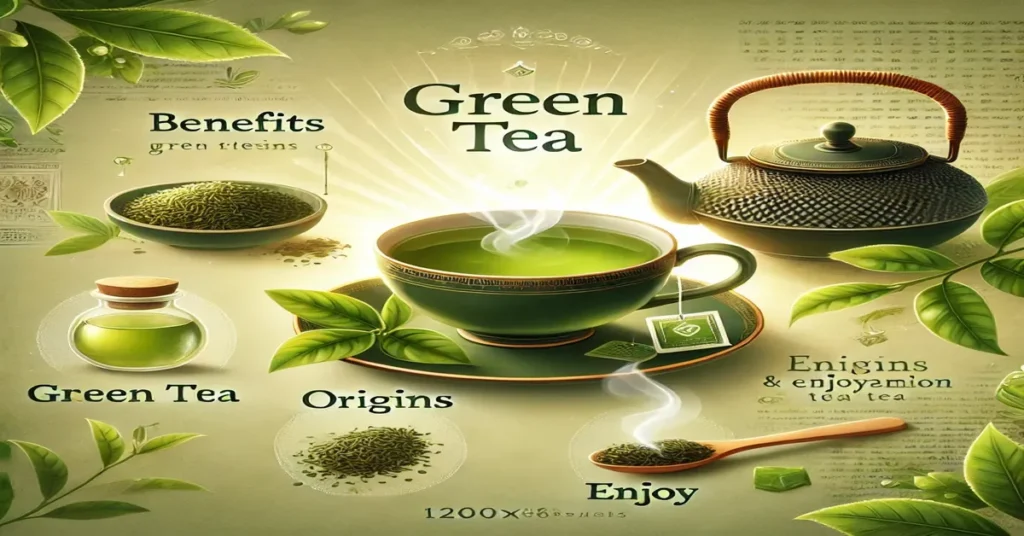Green tea, known as “te verde” in Spanish, has been a revered beverage for centuries. Originating in China and widely consumed across Asia, this tea is celebrated not only for its refreshing taste but also for its myriad health benefits. Over the years, green tea has gained global popularity and is now enjoyed by people from all walks of life who seek a natural, health-promoting drink.
In this article, we will delve into the origins of te verde, its health benefits, types, preparation methods, and ways to incorporate it into your daily routine. We’ll also explore the potential side effects of green tea and how to maximize its health benefits.
Table of Contents
- The Origins and History of Té Verde
- Health Benefits of Green Tea
- Different Types of Green Tea
- How to Prepare and Enjoy Té Verde
- Incorporating Green Tea into Your Daily Routine
- Potential Side Effects and Considerations
- Conclusion
- FAQs
1. The Origins and History of Té Verde
Green tea has a rich history that dates back over 5,000 years. It originated in China during the reign of Emperor Shennong, who, according to legend, discovered tea by accident when tea leaves blew into his boiling water. Fascinated by its refreshing taste and potential health effects, the emperor declared tea a beneficial beverage.
From China, tea spread to Japan in the early 9th century, brought over by Buddhist monks who found that tea helped them stay alert during meditation. Over centuries, the culture of tea expanded across Asia, becoming an integral part of daily life, religious ceremonies, and traditional medicine.
Today, te verde is produced mainly in China and Japan, with some varieties grown in other parts of Asia. It has become a popular beverage worldwide, known for its unique flavor, vibrant color, and numerous health benefits.
2. Health Benefits of Green Tea
One of the primary reasons green tea is so popular is because of its impressive health benefits. Rich in antioxidants and various bioactive compounds, green tea has been linked to several health advantages:
a. Rich in Antioxidants
Green tea contains a high concentration of polyphenols, particularly catechins, which are powerful antioxidants. The most potent catechin in green tea is epigallocatechin gallate (EGCG), known for its ability to reduce oxidative stress and protect cells from damage.
b. Supports Heart Health
Studies have shown that green tea may help lower cholesterol levels and reduce blood pressure, both of which are risk factors for heart disease. Regular consumption of green tea can improve blood flow and reduce the risk of heart attack and stroke.
c. Aids in Weight Loss
Green tea has been linked to fat burning and weight loss, as it can increase metabolism and improve fat oxidation. Many weight loss supplements include green tea extract as a primary ingredient, given its ability to enhance calorie burning.
d. Boosts Brain Function
Caffeine and L-theanine, two compounds found in green tea, work together to improve brain function. Caffeine boosts alertness, while L-theanine promotes relaxation without causing drowsiness. Together, they can enhance concentration, mood, and overall mental performance.
e. May Lower Risk of Cancer
The antioxidants in green tea have been studied for their potential to prevent various types of cancer, including breast, prostate, and colorectal cancer. These antioxidants may reduce the growth of cancerous cells and prevent damage to healthy cells.
f. Enhances Dental Health
Green tea contains catechins, which have antibacterial properties and can improve dental health. Drinking green tea may reduce the growth of harmful bacteria in the mouth, lower the risk of cavities, and improve breath.
g. Supports Skin Health
The anti-inflammatory and antioxidant properties of green tea make it beneficial for skin health. Green tea extracts are commonly used in skincare products for their ability to soothe irritation, reduce acne, and protect the skin from environmental damage.
3. Different Types of Green Tea
Green tea is available in various types, each with unique flavors and preparation methods. Here are some of the most popular varieties:
a. Sencha
Sencha is one of the most commonly consumed green teas in Japan. It has a light, grassy flavor and is typically steamed after harvesting to preserve its vibrant color and fresh taste.
b. Matcha
Matcha is a powdered form of green tea made from shade-grown leaves that are finely ground. It’s known for its intense flavor and is often used in Japanese tea ceremonies. Matcha contains higher concentrations of nutrients and antioxidants compared to other green teas, as the whole leaf is consumed.
c. Gyokuro
Gyokuro is a premium Japanese green tea that is shade-grown before harvest. This process increases the chlorophyll content, giving it a deep green color and a rich, umami flavor.
d. Longjing (Dragon Well)
Longjing, also known as Dragon Well tea, is a popular Chinese green tea with a flat, pan-roasted appearance. It has a sweet, nutty flavor and is often served in China as a symbol of hospitality.
e. Hojicha
Hojicha is a Japanese green tea that is roasted at high temperatures, giving it a warm, toasty flavor. It is low in caffeine and is often enjoyed as an evening tea.
4. How to Prepare and Enjoy Té Verde
The way green tea is prepared can significantly impact its flavor and nutritional value. Here are some tips for brewing the perfect cup of te verde:
a. Use Fresh, High-Quality Tea Leaves
For the best flavor and health benefits, use fresh, high-quality green tea leaves. Avoid tea bags when possible, as loose-leaf teas generally contain higher-quality tea.
b. Pay Attention to Water Temperature
Green tea is delicate and should be brewed at a lower temperature than black tea. The ideal water temperature for most green teas is between 160°F to 180°F (70°C to 80°C). Water that’s too hot can make the tea taste bitter.
c. Steep for the Right Amount of Time
Steep green tea for 1 to 3 minutes, depending on the type and your taste preference. Steeping for too long can release more tannins, resulting in a more bitter flavor.
d. Experiment with Flavors
Green tea pairs well with other flavors like lemon, honey, and mint. You can also experiment with iced green tea, matcha lattes, or even green tea smoothies for variety.
5. Incorporating Green Tea into Your Daily Routine
Green tea can be enjoyed in many ways beyond just drinking it as a hot beverage. Here are a few ideas for incorporating te verde into your daily life:
- Morning Energy Boost: Start your day with a cup of green tea to enhance alertness and boost metabolism.
- Afternoon Relaxation: Enjoy a cup of hojicha or another low-caffeine green tea in the afternoon for a soothing break.
- Green Tea Smoothies: Blend matcha powder into your morning smoothie for a nutritious, antioxidant-rich boost.
- Cooking with Green Tea: Green tea can be used as an ingredient in cooking and baking. Try adding matcha to baked goods, or infuse green tea in rice or broth for unique flavors.
- Skincare: Use green tea extracts or DIY green tea masks for skin health and rejuvenation.
6. Potential Side Effects and Considerations
While green tea is generally safe, excessive consumption may lead to side effects due to its caffeine content and catechins. Here are some things to keep in mind:
a. Caffeine Sensitivity
Green tea contains less caffeine than coffee, but those sensitive to caffeine may still experience jitteriness, anxiety, or difficulty sleeping. Opt for decaffeinated green tea or lower-caffeine varieties like hojicha if you are caffeine-sensitive.
b. Iron Absorption
The catechins in green tea can interfere with iron absorption, especially non-heme iron found in plant foods. To minimize this effect, drink green tea between meals rather than with meals.
c. Stomach Irritation
Some people experience stomach irritation or nausea from drinking green tea on an empty stomach. If this happens, try drinking it after a meal or choose a milder variety.
d. Interaction with Medications
Green tea may interact with certain medications, particularly those affecting blood pressure or blood thinners. Consult with your healthcare provider if you have concerns about green tea interacting with any medications.
Conclusion
Green tea, or te verde, offers a wealth of health benefits and a rich cultural history. From weight management and heart health to brain function and skin benefits, its advantages are backed by both tradition and modern research. Whether you’re savoring a cup of matcha, brewing a pot of sencha, or experimenting with green tea-infused recipes, incorporating this ancient beverage into your lifestyle can be both enjoyable and rewarding.
With a variety of types to choose from and multiple ways to enjoy it, green tea remains one of the most versatile and beneficial beverages. Just be mindful of potential side effects, especially if you are sensitive to caffeine or take medications. Embrace the tradition, flavors, and health benefits of te verde as part of a balanced, health-conscious lifestyle.
FAQs
1. How much green tea should I drink daily for health benefits?
Most studies suggest drinking 2 to 3 cups of green tea per day to enjoy its health benefits.
2. Can green tea help me lose weight?
Green tea can aid weight loss by boosting metabolism and fat oxidation, but it should be combined with a balanced diet and exercise.
3. Is it safe to drink green tea every day?
Yes, drinking green tea daily is safe for most people. However, it’s best to moderate intake if you are sensitive to caffeine.
4. What’s the best time to drink green tea?
The best times to drink green tea are in the morning and early afternoon. Avoid drinking it late at night to prevent sleep disturbances.
5. Can I add sugar or milk to green tea?
While adding sugar or milk is a personal preference, it can alter the tea’s natural flavor and may reduce some health benefits. Honey or lemon can be good alternatives.
6. Which type of green tea is the healthiest?
Matcha is considered one of the healthiest types of green tea due to its high concentration of antioxidants, as the entire leaf is consumed.







